http://k.daum.net/qna/view.html?qid=2jc63&category_id=QQO&q=%B3%AF%BE%BE
Search This Blog
Monday, January 31, 2011
어제 아래 경상도 사투리
http://k.daum.net/qna/view.html?qid=2jc63&category_id=QQO&q=%B3%AF%BE%BE
Sunday, January 30, 2011
<유치장 입감 해적들, 밥 싹 비우고 숙면>
"한국 식사 어떠냐"고 묻자 "굿, 굿!"
(부산=연합뉴스) 오수희 기자 = 30일 새벽 부산으로 압송돼 7시간여 동안 조사를 받고 부산해양경찰서 유치장에 입감된 소말리아 해적 5명은 입감 첫 날밤 식사를 싹 비우고 단 한번도 깨지 않고 숙면을 취한 것으로 파악됐다.
31일 부산해양경찰서에 따르면 수사본부에서 조사를 마친 해적들은 30일 오후 6시30분 부산해양경찰서에 도착했다. 신체검사를 받은 뒤 유치장 안전수칙 교육을 받은 뒤 오후 7시 정식 입감됐다. 이들은 3개 호실에 2명, 2명, 1명으로 나뉘어 입감됐다.
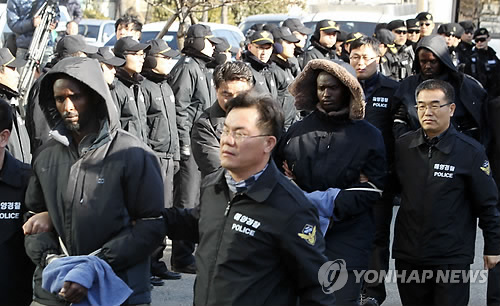

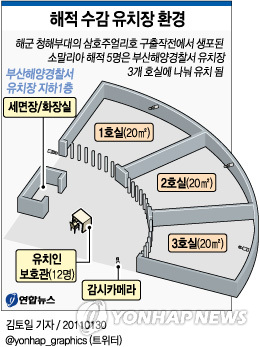
해적들은 밤새 단 한번도 뒤척이거나 깨지 않고 숙면을 취했다고 부산해경은 전했다.
31일 오전 7시에 일어나 세면을 한 뒤 오전 7시30분 쌀밥, 동탯국, 계란 프라이, 김치, 두부 메뉴로 구성된 아침식사를 했다. 해적들은 역시 조금도 남기지 않고 식사를 끝냈다.
"한국 음식 먹을만 하냐?"고 영어로 묻자 해적 중 한 명이 "굿, 굿"이라고 대답했다고 부산해경은 전했다.
부산해경 관계자는 "해적들은 두려워하거나 긴장한 표정 없이 담담하게 유치장에서 첫 밤을 보냈다"며 "중대 범인이긴 하지만 '외국인 해적'이라는 피의자 특수성을 고려해 유치인 보호에 최선을 다할 것"이라고 말했다.
한편 해적들은 31일 오전 8시30분께 부산해경을 떠나 오전 9시께 특별수사본부가 있는 남해지방해양경찰청에 도착, 이틀째 조사받을 예정이다.
osh9981@yna.co.kr
http://media.daum.net/economic/industry/cluster_list.html?newsid=20110131081905996&clusterid=278664&clusternewsid=20110131081905996&p=yonhap&t__nil_news=uptxt&nil_id=8&scrollTo=writeForm
Tuesday, January 18, 2011
China's Physical Culture and Sports Industrialized
China's Physical Culture and Sports Industrialized
by Our Staff Reporter Wang Chen
For a long time, sports have been, for the Chinese, only a pursuit of an ideal, a career used to win honor for the country, and a means to build up health. It has been considered a purely consumptive undertaking operating completely with state allocations.
However, in the early 1980s when China began moving onto the world sports arena in an all-round way, and especially with the increased pace of the reform drive, sports-related industries began developing rapidly. At the First National Sports Goods Fair in 1993, there were only 100 exhibiting booths, and the volume of business was 100 million yuan. At the fourth fair in 1997, however, 1,412 domestic and foreign businesses took part, and orders totaled 6 billion yuan.
Li Ning, an Olympic champion now general manager of the Li Ning Sports Goods Group, asks, "What role will China's sports undertakings play in the nation's economic development in the 21st century? Is it possible that the sector will become one of the country's high-developing industries?"
In the eyes of many businesses, China's sport industry is like a submerged gold mountain coming gradually to the surface.
Industrialization: The Only Way
Last October, the 8th National Games, the largest in Chinese sports history, were held in Shanghai. A total of 5.6 billion yuan was spent in renovating and building stadiums and gymnasiums, and on the organization and running of the games. However, four years ago when Shanghai applied for the right to hold the event, the state promised to appropriate only 80 million yuan toward funding it. It would simply have been impossible to hold such a grand event by relying on the meager state allocation, should it occur in the past.
So, Shanghai had to rely on sports to support sports. During the preparatory stage, the organizing committee used different fund-raising methods, including the operation of joint ventures, comprehensive development of venues, sale of advertising rights, lotteries, the naming right and the sale of television broadcasting rights. Near the main stadium, the "Road of Sports Lovers" was opened on which the names of donors were displayed. A sports goods fair was also held on the site. Thus, the value of sports was fully exploited in many different ways in order to guarantee sufficient fund availability.
This was in sharp contrast to the Asian Games held in Beijing eight years ago, when 60 percent of the needed investment came from state appropriations and the Beijing municipal government.
The great disparity, in fact, demonstrates the tremendous power of sports industrialization.
According to the State Physical Culture and Sports Commission, over the past few years, the sports industry has registered an annual growth of around 30 percent in output value. If it is guided and developed in a more effective way, the industry not only can meet its self-development needs, but also become a new economic growth spot.
In the Outline of the Ninth Five-Year Plan for National Economic and Social Development and Long-Range Objectives Through the Year 2010, adopted by the National People's Congress last year, it was made clear that Chinese sports should "form a pattern, in which the state, social organizations and individuals make joint efforts to run a proper sports undertaking, and follow the road to socialization and industrialization".
Size of the Market
Over the past few years, professional league football matches have become the most popular spectator sports in China. These are operated to mirror long-existing Western practices in soccer administration, and have brought tremendous economic profits for the teams and their players.
A survey of six large cities shows that about 20 percent of the local population are football fans. Among them, almost three-quarters have followed the game for at least six years. Take Beijing for example. The metropolis has a population of 11 million, producing about 2.2 million football fans--a lucrative base for a range of related industries.
One football products businessman said that marketing posed no problem if the goods produced comply with the Chinese people's psychology of appreciation, values, morality and habits.
During the current decade, there has been a rapid growth in the Chinese sports industry, whose prospects look endless. "With the change of the Engel coefficient in Chinese society, it is natural for the people to think about leisure and sports after they have met their basic needs for food, clothing and housing. At a time when Chinese consumption has reached Western levels, it is hard for sports businessmen to imagine how large the market will be in a country like China with a population of 1.2 billion," said Zhang Zhuo, a sociologist with the Chinese Academy of Social Sciences.
Only Beginning
Last December, the State Physical Culture and Sports Commission (SPCSC) disbanded three training and competition departments and founded nine management centers in track and field, swimming, basketball, volleyball, gymnastics, table tennis, badminton and other events. So far, more than 80 sports events have separated themselves from the direct SPCSC management, and have been put under the administration of 20 sports management centers in the nature of economic entities.
According to Xu Chuan, head of the SPCSC Policy Research Division, a sports management center is a unique form of administration created by China. They have independent management rights and are no longer pure government departments.
The large-scale restructuring is the first step taken by SPCSC to meet the needs of the industrialization drive. It also demonstrates that the standardized development of sports industries has just begun in China.
Li Ning, for example, noted that the sector remains small and weak, with low output value. In spite of China's great market potential, the annual sales value of sports goods only reaches 30 billion yuan, a far cry from the global figure of between US$200-300 billion. China's annual income of 200 million yuan from football, when compared with the world annual transaction volume of US$250 billion, is but a drop in the ocean.
"The development of China's sports industries is only a beginning, and it still has a long way to go," said Wu Shaozu, SPCSC minister. "If we put our efforts into improving the quality of sports goods, enhancing the overall level of sports industries, and standardize the management of the sports market, I dare to say that the sports industry will become a new economic growth point."
Opportunities and Competitions
One of the outstanding achievements of the world famous International Management Group (IMG) has been the management of China's league football matches. Its business grew further in 1995 through the investment of US$1.2 million to manage the domestic basketball national league.
League matches in the two events have not only brought in tremendous profits to IMG, but also gained a lion's share of the domestic sports market. A responsible member of the China Department of IMG states that the organization had benefited considerably from choosing the correct opportunity and correct business direction.
The competition has intensified amid a surge of business opportunities. But not everyone has succeeded. Two years ago, for example, a Hong Kong company sought to gain control of mainland sports sponsorship, but it had to give up due to insufficient funding.
Compared with the activities of foreign companies, domestic businesses have been slow to act. An investigation of two major international events held in Beijing in 1996 and 1997 showed 90 percent of the financing came from overseas firms.
Some old-brand sports firms were squeezed out of the market because they could not cope with the new challenges, such as the Touch brand which was popular in the 1950s-60s. Brands such as Li Ning, however, are in great demand.
Just as Li Ning said, developing China's potential sports market calls for clear-minded businessmen to seize opportunities in the face of acute competition.
http://202.194.48.102/englishonline/bjzs/BeijingReview/98Apr/Trora98-13-9.asp?
http://www.google.com/#hl=ko&xhr=t&q=%22professional+league+football+matches+have+become+the+most+popular+spectator+sports+in+China%22&cp=92&pf=p&sclient=psy&aq=f&aqi=&aql=&oq=%22professional+league+football+matches+have+become+the+most+popular+spectator+sports+in+China%22&pbx=1&fp=5a2a310ba83c8894
Saturday, January 15, 2011
급발진 나면 나자마자 이그니션키 돌려
http://tvnews.media.daum.net/view.html?tvcateid=100000&newsid=20110115212726330&p=sbsi&allComment=T&commentViewOption=true&commentId=80084140&listSortKey=depth&listAllComment=T&listPageIndex=1&cView=view
What is the world record for vertical jump?
The world record vertical jump has been said to be 61" (155 cm) by Kadour Ziani(Football player from france), more than twice the avg of an NBA player. ChaCha
http://www.chacha.com/question/what-is-the-world-record-for-vertical-jump
basketball vertical
It would have to be an olympic Volleyball player of some sort. Those guys are ridiculous with verticals. Also, contrary to popular belief, NBA players do not have high verticals and almost all of them are under 40″. NFL players actually have higher verts than NBA players and track and field sprinters(nationally or world ranked) have higher verticals also.
Think about it, if Lebron really had the 44″ vert they say he has, he would be able to stand under the goal flat footed and leap and get his head 4″ over the rim. He might be able to do that, and I respect his jumping ability, however the numbers that people throw around are blown up. MJ’s real vert at the Birmingham Barrons in 1993 was 38″, that was right out of basketball so don’t say he was out of shape or something.
Leonel Marshal from cuba actually does have close to a 50″ vertical. Go watch some videos on youtube, and remember the volleyball net they play on is around 8′. Also Michael Wilson from the globe trotters was pretty amazing.
http://canitraintojumphigher.info/highest-vertical-jump-world-record/
Olympic Lifters(snatch/clean) have outrun world class sprinters
http://www.youtube.com/watch?v=IAsv_WhHPVU
You can do your squats as fast as you want, it makes ZERO difference
You can do your squats as fast as you want, it makes ZERO difference, under heavy resistance it's fast twitch B fibers contracting. By squatting slowly, you are increasing strength and this allows greater force application while in the drive phase as well as greater force application overall.
In fact if you are squatting really fast, you are using too light weight and wont develop the necessary strength, or you'd be using really light weight for jump squats. But where is the strength base and how is it going to develop if you dont do any max strength training?
Power is also greatly based on mass and strength, however as I said, it is all about strength to mass ratio, you are moving your own body weight, therefore how much force you apply to the ground is important but if you're too heavy and not strong enough for your body weight, you wont be moving your mass quick enough.
http://forum.bodybuilding.com/showthread.php?t=6452741&highlight=body+mass+to+strength+ratio
복부 지방흡입 하면 가슴이 커질 수 있다?
오늘은 사회적 파장(?)이 쵸큼 걱정되긴 하지만 얼마전 가슴에 관한 글을 쓰면서 곁다리로 달려있던, 저의 눈길을 확~ 사로 잡았던 연구 2편을 소개해 보고자 합니다. 바로 복부의 지방 흡입을 하면 가슴이 커질 수 있다는 연구입니다.
사 실 이전부터 복부 지방흡입을 하면 가슴이 커지는 놀라운 기적이 보고된다는 전설과 같은 소문(?)은 익히 들었었습니다. 하지만 이 전설(?)이 얼마나 신빙성이 있는 것인지는 개인적으로 좀 의문스러웠었죠...그러던 와중에 이 두개의 연구를 발견(?) 하고 나서는 그 전설의 신비가 어느 정도는 풀렸습니다.
그럼 지금부터 그 연구 결과를 만나 보시죠 ^^
Stormy Daniels by Thomas Hawk ![]()
![]()
복부 지방흡입 했더니 가슴이 커졌다?
[연구 1 : Breast Enlargement Induced by Liposuction ; Dermatol Surg 2003;29:928–930]
우선 첫번째 연구는 복부 지방흡입을 받은 44명의 여성과 다른 미용 시술을 받은 27명의 여성의 시술 전후 착용하는 브레이지어 사이즈의 변화가 있는지를 전화와 직접 면담을 통해 알아본 연구였습니다.
이 연구 결과 복부 지방흡입을 한 44명의 여성 중 19명이 사용하는 브레이지어가 커지거나 같은 브레이지어가 좀 더 꽉 맞게 되었다고 응답한 반면, 다른 미용 수술을 받은 27명의 여성 중 1명만이 큰 브래이지어를 착용하게 되었다고 응답했습니다.
이 연구에서 재미(?)있는 것은 브래이지어의 사이즈가 커진것이 체중의 증가와 무관했다는 점입니다.
[연구 2 : Spontaneous Breast Enlargement following Liposuction of the Abdominal Wall: Does a
Link Exist? - Plast. Reconstr. Surg. 119: 1584, 2007]
두번째 연구는 복부 지방흡입을 받았던 48명의 여성과 다른 시술(abdominoplasty)를 시행받은 53명의 여성을 대상으로 시술 전 후에 브레이지어 CUP size의 변화가 있는지를 살펴보았습니다.
이 연구의 결과 복부 지방흡입을 받은 48명의 여성 중 19명이 객관적으로 브레이지어 CUP size의 증가가 있던반면 다른 시술(abdominoplasty)를 받은 53명 중 6명만이 브레이지어 CUP size가 증가했습니다.
이 연구에서는 앞에서와 다르게 체중의 증가가 브래지어 cup size 증가에 영향을 미친것으로 나타났습니다.
왜 이런 일이 생길까?
자 그럼 복부 지방 흡입을 했는게 가슴이 커지는 부작용(?)이 생기는 이유는 무엇일까요? 아직 정확히 밝혀진건 아니지만 박사님들은 그 이유를 '호르몬'에서 찾고 있었습니다.
많 은 분들이 지방을 단지 에너지를 저장하는 에너지 저장고로만 알고 있는데 그렇지 않습니다. 이제 지방세포는 호르몬을 분비하는 중요한 역할도 한다고 알려져 있지요. 대표적인 예로 여성의 경우 체지방률이 너무 떨어져 체지방이 과도하게 줄어들면 (대략 15%이하) 월경불순이 생길 수 있는데요 이것또한 지방에서 분비되는 호르몬에 문제가 생기기 때문입니다. 어쨋든....
지방세포는 남성호르몬(테스토스테론)과 여성호르몬(에스트로겐)을 일정 비율로 분비하는데 복부 지방은 여성 호르몬보다 남성 호르몬을 10배 정도 많이 분비합니다. 그런데 지방흡입으로 복부의 지방을 줄여 놓으면 남성호르몬을 많이 분비하던 지방이 없어졌으니 상대적으로 몸 속 여성호르몬 분비가 늘어나고 그 결과 가슴이 커진다는 것이지요.
근데 가슴만 커질까?
여기서 궁금증이 하나 생깁니다. 복부의 지방흡입을 하면 가슴이 커지는 것이 여성 호르몬의 비율이 높아지기 때문이라면..... 과연 가슴만 커질까요? 여성 호르몬의 영향을 받는 엉덩이나 허벅지는 어떨까요?
젊은 여성이 승마바지와 같은 허벅지를 가지게 되는 것은 여성 호르몬에 영향을 받기 때문이라고 알려져 있습니다.
따라서 연구 결과에 나타나지 않아서 그렇지 복부 지방 흡입을 하면 여성 호르몬 비율이 상대적으로 증가하면서 가슴이 커질 수 있지만 엉덩이나 허벅지의 지방량도 늘어날수도 있을것이라는 추측을 해볼 수 있을거 같습니다.
사실 이번 글을 쓰면서 자칫 이 글이 복부 지방흡입을 부축이는(?) 글로 변질되지 않을까 우려를 했습니다. 뱃살을 줄이는 시술을 했는데 가슴이 커지는 놀라운 기적이 일어날 수 있다는 소문은 여성들에게 꽤나 달콤한 유혹일 수 있을테니까요.......
하지만 위에서 말했듯이 그 원리를 따져보면 여성분들이 지긋지긋해 하는 허벅지의 지방또한 늘어날 위험성도 있다고 추측해 볼 수 있을겁니다. 따라서 복부 지방 흡입을 무조건 1석2조의 신비의 시술로 받아들여서는 안될 거 같네요.
이 글의 내용은 그저 재미(?) 또는 새로운 상식(?) 정도로 받아 들이시면 좋을 듯 합니다. 혹시 복부 지방흡입을 하시고 그와 더불어 허벅지 지방의 증가 없이 가슴만 커진 여성분이 있다면 축하(?)한다는 말씀을 전하면서 글을 마무리 합니다. ^^
http://mania.geopia.com/?view=view&mode=all&category=35&idx=10008&searchType=&searchValue=&page=1
역도 선수들의 힘은 어디서 나올까? - 1
역도 선수들의 파워는 어마어마합니다. 체중의 3배까지 중량을 들어올리죠.
사람들은 대부분 생각하기를 역도 선수들이 힘만 쎄고 둔한 미련한 운동선수라고 생각하는 경향이 있습니다.
하지만 실제로는 역도 선수들은
육상 선수 중 100미터 스프린터들을 제외하고 가장 빨리 달릴 수 있고
육상 선수 중 높이뛰기 선수들을 제외하고 수직 점프 능력이 가장 좋습니다.
실제로 예전에 농구, 배구, 역도, 레슬링(올림픽 레슬링입니다 프로레슬링 말고요 ㅋ)
네 개의 종목 선수들을 가지고 수직 점프 능력을 테스트 했는데 1위가 역도 2위가 레슬링이 나왔다고 합니다.
상식적으로 덩크 슛을 날리는 농구 선수나 네트 위로 블로킹을 해대는 배구 선수가 수직 점프가 더 나올 것 같지만
실제적인 결과는 그렇지 않았다는 것입니다.
땅위에 붙어다니면서 무거운 중량만 무식하게(?) 들었다 놨다 하는 둔하고 미련한 역도 선수가 1위가 나왔다는 것입니다.
비결은 무엇일까요?
저는 그 비결을 스쿼트와 순간적으로 일어나는 파워(power)에서 나온다고 봅니다.
파워는 힘에다가 시간의 개념을 넣은 것입니다.
즉 단위 시간당 얼마나 많은 힘을 낼 수 있을수록 파워는 세지는 거죠.
힘 좀더 정확히 말하면 근력(strength)는 시간의 개념이 없습니다. 그냥 들어올리면 되는 겁니다.
위의 그림은 역도의 종목 중의 하나인 인상을 할 때의 사진을 연속으로 세개를 촬영한 것입니다.
첫번째 사진을 본다면 영락없이 데드리프트의 자세입니다.
두번째 사진까지는 데드리프트인데 세번째부터 틀려집니다.
갑자기 바벨을 쇄골높이까지 들어올리면서 무릎을 굽히는 모습이 나옵니다.
저기서 무릎을 더 굽혀서 완전히 앉아버리고 팔을 하늘로 쭈욱 뻗어버리면 이게 바로 역도에서의 인상이 되는 겁니다.
이것을 파워리프터들이 들어올리듯이 천천히 쭉 들어올리면 들 수 있을까요?
여기서 필요한 것이 파워(power)입니다.
한번에 확 들어올리면서 무릎은 갑자기 굽혀져서 실제로 바벨을 들어올리는 높이는 얼마 안됩니다.
중량의 높이는 유지하면서 몸만 낮춘다고 해야 할까요?
이렇게 해서 바로 위의 선수처럼 완전히 쪼그려 앉으면서 팔을 하늘 위로 쭉 뻗은 자세...
여기까지가 역도에서의 스내치(snatch)라는 동작입니다.
다음 편에서 계속 다루겠습니다.
덧붙이는 말) 실제로 사진과 글 만으로 역도 선수의 겉으로 보기에는 단순해 보이지만 상당히 복잡한 동작을 설명한다는 것은 무가 있습니다. 그냥 재미삼아서 보시라고 쓴 글이기에 편하게 봐주셨으면 합니다.
(작성자)Fitness leader
(출처)새로운 발전을 위해 노력하는 피트니스 리더들의 모임
http://cafe.daum.net/korea-ptf
이 글은 저작권법에 의해 보호됩니다. 작성자와 출처 표시없이 무단으로 도용하거나 임의로 삭제 및 수정하는 것을 금합니다.
http://mania.geopia.com/?view=view&mode=best&category=35&idx=9404&searchType=&searchValue=&page=7
선수들의 근력 훈련, 금벅지의 비밀
육상 단거리 선수 몸매가 보디빌더처럼 보이는 이유
일반 상식으로 달리기하는데 하체 힘을 많이 사용하기 때문에 하체 근육 발달에 중요하다고 생각하게 된다. 하지만 빠른 속력을 얻기 위해서는 상·하체 근육 발달과 밸런스를 유지하는 것이 중요하다.
육상 단거리는 짧은 시간에 폭팔적인 힘을 내야하기 때문에 근육 속에 많은 에너지(ATP)를 저장되어야한다. 즉 산소 공급 없이(숨을 쉬지 않고) 몸 속의 근육의 힘으로만 스피드를 내야하는 단거리 선수들은 웨이트 트레이닝을 통하여 근육을 키우는 것이다. 따라서 육상 단거리 선수들의 몸매는 점점 보디빌더처럼 변화되고 있다.
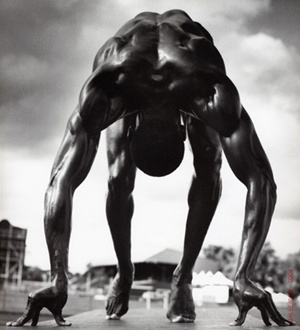
과거 육상 단거리 선수들의 모습을 보면 현재와 같이 상체 근육이 발달 되지 않은 모습을 볼 수 있다. 스포츠 과학이 발달되면서 힘의 원리를 규명하게 되어 보다 빠른 가속도를 얻기 위해서는 보다 많은 상체 근육의 중요성을 알게 되었다. 상체 근육이 발달되면 하체 근육을 보다 빠르게 활성화 시켜 빠른 속도를 얻게하는 작용하기 때문에 많은 육상 단거리 선수들은 하체 못지 않게 상체 근력 운동을 많이 한다.
결론적으로 근육 속에 에너지를 많이 축적하여 보다 빠른 스피드를 내기 위해 육상 단거리 선수들의 몸매는 점점 보디빌더처럼 만들어질 것이다. 무산소 운동 기능 향상의 핵심 트레이닝이 바로 웨이트 트레이닝이기 때문에 육상 단거리 선수들은 지속적으로 덤벨을 들어 올리 수 밖에 없다.
Q) 30m 달리기에서 가장 빠르게 질주하는 선수? 1.역도 2. 태권도 3. 축구 4. 야구 5. 핸드볼
http://koreatakraw.com/1219
Saturday, January 8, 2011
모이고?
마찬가지로 경남방언에서도 크게 낙동강을 기준으로 해서 동부, 서부 말의 억양이나 단어가 다소 차이가 납니다.
형의 경우도, 새이, 히야, 햄(소세지가 아닙니다) 등등...
저의 이모님댁은 기장이고 모친의 고향은 경주인데, 어릴적 이모님들이 사용하는 말을 들어보니, 형을 새이라고 하더군요. 울산, 경주지방 분들도 이렇게 사용하시더군요.
마이클 잭슨의 새이 새이 새이라는 노래는 그럼...?? (라이오넬 리치의 새이유 새이미도 잇꾸요.^^)
혹시 오줄없다는 말 아십니까? 널픈수 없다. 주책없다. 융통성이 없다 등의 뜻입니다.
그리고 진주, 남해 등지의 말도 부산사투리와는 다릅니다. 뭐시라? 뭐이고? 뭐이라? (무엇이라? 무엇이라고? 의 뜻) 등등....^^
부산사투리는 오리지날 부산사투리가 아닙니다. 마치 서울근처에도 경기도 사투리가 잇듯이(수원 부근에서 쓰는 충기도 말 비스무리한??). 그리고 부산사투리라는 것은 원래는 없엇습니다. 경남 사투리 중에서 하나의 소군락이었을 뿐이었지요. 한국동란때 피난 오신 분들의 사투리에서 단어, 억양이 적지 않게 유입되어 혼합된 것 같습니다.
참고로 이북사투리, 특히 함경도 사투리와 경상도 방언에서 유사한 점을 찾을 수 있습니다. 기본적인 억양은 상당히 비슷합니다.이 이유는 조선시대, 많은 경상도 사람들이 북쪽으로 이주햇다고 합니다. 북진정책아시죠?
또한 연변 사투리 역시, 오리지날 이북말이 아닙니다. 서울에서 생활할때 조선족 한분을 알고 있엇는데, 그분 왈, 구한말에서 일제시기 많은 사람들이 경상도에서 만주로 이주했는데요, 이분들의 사투리와 중국어, 이북에서 오신분들의 이북사투리가 잠봉된 것이라고 하더군요.
걸인
2002.10.06 01:30:02
211.206.221.214
혹시
"꼴배졌다"란 말뜻을 아시는 분이 계실까?....(물론 부산토박이분 들 포함하여...)
기장바닷가 쪽에서만 것도 지금은 거의 쓰지 않는 기장사투리죠....
"꼴배졌다=뒤집혔다" 랍니다.^^
http://www.enjoyaudio.com/zbxe/?document_srl=616929
Blog Archive
-
▼
2011
(1292)
-
▼
January
(14)
- 어제 아래 경상도 사투리
- <유치장 입감 해적들, 밥 싹 비우고 숙면>
- China's Physical Culture and Sports Industrialized
- 급발진 나면 나자마자 이그니션키 돌려
- What is the world record for vertical jump?
- Michael Jordan media hype
- basketball vertical
- Olympic Lifters(snatch/clean) have outrun world cl...
- You can do your squats as fast as you want, it mak...
- 복부 지방흡입 하면 가슴이 커질 수 있다?
- 역도 선수들의 힘은 어디서 나올까? - 1
- 선수들의 근력 훈련, 금벅지의 비밀
- 육상 단거리 선수 몸매가 보디빌더처럼 보이는 이유
- 모이고?
-
▼
January
(14)
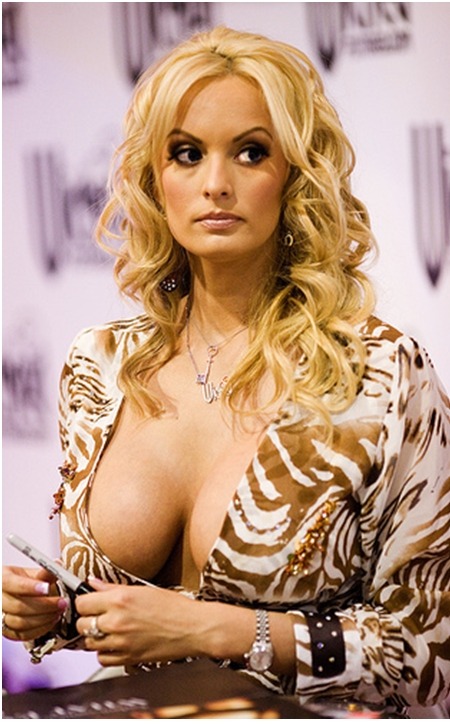
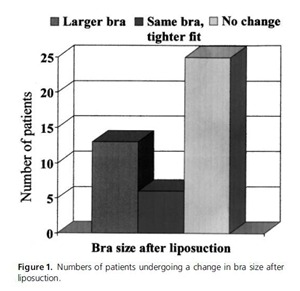
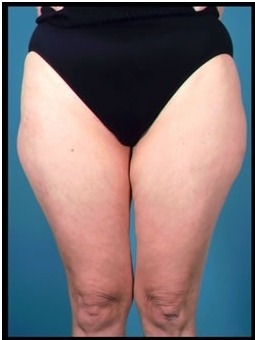
MJ being GOAT is media hype?
Is it safe to say that Michael Jordan is the GOAT of basketball because of all the media hype he gotten?
Its obvious that players such as Magic Johnson, Wilt Chamberlain, and Kareem Abdul’s accomplished more than Michael Jordan did. And what more is that during their careers they still dominated and took their less-stellar teams to deep play-off runs than MJ and won MVPs.
MJ practically did NOTHING without Pippen, meanwhile Wilt Chamberlain was simply the cornerstone of the NBA single-handly winning a championship. Kareem Abdul’s won a championship with the Bucks with NO all-star teammate. After Kareem retired Magic still continued to dominant and take his team to deep play-off runs until his early retirement.
BTW Wilt would easily outclass anyone in today’s NBA. Wilt was not simply a product of a era, Wilt would be considered a world-class athlete even in today’s standards, a better athlete than LEBRON JAMES! Check out his combine stats while he attended KU, 40 yard dash was in the mid 4s, vertical was in the high 30s, and he was setting school records in long jump. Wilt even lead the league in assists simply because his coach told him to get the team more involved. He may not get the same bloated stats, but you cant seriously tell me he would get 30 pts / 15 rebounds/ 5+ assists a night if he could be summoned in his prime in today’s NBA.
P.S. How did Michael exactly “change” the game? If it wasnt for Pippen he woulda just been another all-star player. Having the media ride your jock doesnt mena you changed the game, it means you were marketable, which is all find and dandy but it does NOT make you a better player. Michael Jordan without question is a top 5 all-time kinda player, but to label him as the undisputed basketball god is ignorant.
@Adam you borderline retard, did I even mention Kobe in this question? Gtfo and read before you say something ignorant like that again.
@Darth Vader Ok so I may have mistaken and forgot about Oscar Robertson, but a VERY old Oscar. How does not having a 3pt back then take away Wilt’s amazing athleteism and obviously being superior than 90% of all NBA players? So what if jordan was a olympian? So was Charles Barkley but would you say he’s a GOAT? Its a known fact Jordan did very little until the arrival of Pippen. You obviously dont understand basketball and a Jordan Jocker as your arguements hold little to NO value with the exception of correction of me forgetting Oscar Robertson. Jordan couldnt even escape the 1st round without Pippen. 95% of what you said was already known and redundent infomation
http://canitraintojumphigher.info/highest-vertical-jump-world-record/